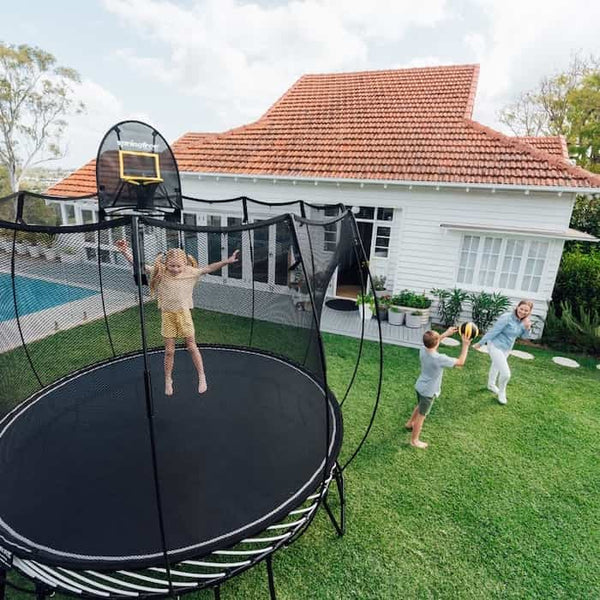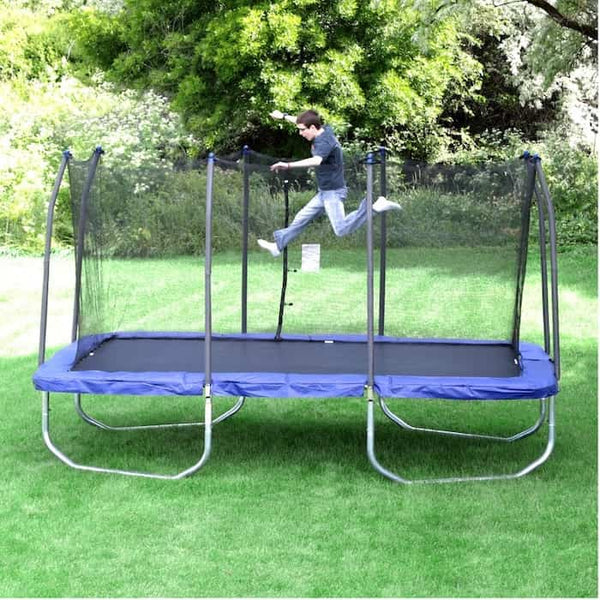What Shape Trampoline Is Best? | Expert Insights Revealed
Jump right! Discover the best trampoline shape for you as our experts reveal how shape affects your bounce and safety. Don't miss these crucial insights!
min read

There are four common trampoline shapes: Round, rectangular, square and oval.
The shape of trampoline can have a significant impact on your jumping experience.
It’s one of the most underrated factors to consider when buying a trampoline.
What shape trampoline is best for you?
That is the question we will use our decades of trampoline expertise to answer today. Make sure to read closely, as the best trampoline shape could be different for everyone.
The 4 Types of Trampoline Shapes
As mentioned in the introduction, there are four common shapes for backyard trampolines. Let’s run through each of them in more detail:
1. Round Trampolines
Round trampolines are the most common trampoline shape. If you had a trampoline as a child, it was likely round.
They are known for their uniform bounce and the natural tendency to pull jumpers back toward the centre, making them an excellent choice for beginners.

Springfree Trampoline.
Pros:
- Safer for beginners due to the centralizing bounce.
- Usually more affordable than other shapes.
- Comes in various sizes to fit different spaces and budgets.
Cons:
- Less surface area for jumping compared to rectangular models.
- The bounce is not as powerful, which may not suit advanced jumpers or gymnasts.
2. Rectangular Trampolines
Rectangular trampolines, another common shape, are often the go-to for athletes, like gymnasts and cheerleaders.
They maintain an even distribution of springs which allows for a more powerful bounce and greater control over jumps.

Photo courtesy of Wayfair.
Pros:
- Preferred by athletes for the high-performance bounce.
- Offers more room for flips and acrobatics. Note: We recommend not doing advanced tricks unless professionally trained.
- Can fit into long, narrow spaces due to their shape.
Cons:
- Typically, rectangle trampolines are more expensive due to the construction and materials.
- Not as forgiving for novice jumpers as the round ones.
Check out our Rectangle vs. Round Trampolines analysis for a comparison between the trampoline shapes on costs, safety and much more!
3. Square Trampolines
Square trampolines offer a nice middle ground between round and rectangular options.
They provide the space-saving benefits of a round trampoline with a bounce that is somewhat similar to a rectangular one.

Springfree Trampoline.
Pros:
- Maximize corner-to-corner jumping room.
- The bounce is more uniform than round trampolines.
- Fits well in corners and limited spaces (although this could depend on which trampoline size you choose).
Cons:
- More expensive due to its unique shape.
- Not as common as other trampoline shapes.
4. Oval Trampolines
Oval trampolines, while less common than round and rectangular trampolines, provide a long platform to jump.
It can double as a beginner’s trampoline or be used for athletic purposes.

Springfree Trampoline.
Pros:
- The elongated shape offers more room for activities and moves.
- The bounce is typically less forceful for younger children than square or rectangular trampolines.
- Offers space flexibility for long and narrow backyards.
Cons:
- Can be pricey due to the unique shape and are not as common as other shapes.
- May require more space in the yard compared to round ones.
Check out our 4 Best Oval Trampolines for this year!
Which Shape Trampoline Is Best?
After seeing the four trampoline shapes, which one is the best?
This is going to depend on your goals for a trampoline.
There’s no definitive answer on which shape trampoline is the best – it will be situation-specific.
How to Choose the Right Trampoline Shape
The following factors will influence which shape of trampoline you need:
- Intended Use - Determine the primary purpose of the trampoline. Is it for recreational bouncing, fitness, gymnastics, or other specific activities?
- Available Space - Measure the area where you plan to set up the trampoline to ensure it accommodates the chosen shape without overcrowding or obstruction. We recommend 3-5 ft of clearance space around the trampoline for safety.

- Safety - Consider the safety features of each shape. Round trampolines tend to direct users towards the centre, reducing the risk of falling off, while rectangular trampolines offer more controlled bouncing for activities like gymnastics.
- Bounce Quality - Assess the bounce quality of each shape. Round trampolines typically offer a softer bounce suitable for general recreational use. Other shapes like rectangular and square trampolines may provide a higher bounce and optimal space preferred for gymnastics and tumbling.
- Budget - Determine your budget and consider the trampoline cost differences between various shapes.
- Durability - Evaluate the durability of each shape, considering factors such as frame materials, spring quality, proper UV treatment, etc. A well-built trampoline can withstand regular use and weather conditions for years to come.
FAQ: Trampoline Shapes
We’re going to run through some commonly asked questions and provide an expert perspective on which shape to choose.
1. What Is the Bounciest Trampoline Shape?
The bounciest trampoline shape will depend on factors like the trampoline size, the mat weave, spring size/quality and the size of the jumper.
If the same jumper bounced on the different trampoline shapes, rectangular and square trampolines would likely provide the best bounce. This is due to a more consistent tension across the mat.
2. What Shape Trampoline Is Best for Kids?
If you have young children, we recommend looking at a round or oval-shaped trampoline to start.
These trampoline shapes offer a more controlled bounce, pulling jumpers toward the centre of the mat – which is the safest part.
However, if your child has long-term trampoline ambitions, it would be worth it to invest in a square or rectangular trampoline.
This will ensure that your child will have plenty of room to jump as they grow!
3. What Is the Best Shape Trampoline for Gymnastics?
For gymnastics or tumbling, you need a longer trampoline.
We would recommend a large oval, rectangular or square trampoline shape for gymnastics.
You also want to ensure you get a size that will be large enough to grow with your child. This might mean purchasing a 13 ft trampoline or bigger.
4. What Are the Advantages of a Square Trampoline?
Square trampolines offer advantages such as more even bounce distribution, enhanced corner-to-corner jumping room and ample space for multiple users if allowed (we recommend following a “One Jumper at a Time Rule”).
Square-shaped trampolines are often more expensive due to the precision engineering required for their construction. They are uniquely built, which is why you don’t see many on the market.
5. Is a Round or Oval Trampoline Better?
Both have their advantages. A round trampoline is better for general bouncing activities as it distributes weight evenly and provides a predictable rebound.
An oval trampoline offers a compromise between the stability of a round trampoline and the space efficiency of a rectangular one.
If your child is younger but interested in trampolining, the oval trampoline shape would be a better fit.
6. Which Is Safer, Round or Rectangle Trampoline?
This really depends on the quality and build of the trampoline.
You could argue that a round trampoline is safer than a rectangular trampoline due to its propensity to pull the jumper to the centre of the mat.
However, a cheap round trampoline will not be as safe as a high-quality rectangle trampoline or vice-versa.
What Size Trampoline Do You Need?
The shape of trampoline you choose for your backyard is crucial.
Use this article to help set your goals. Start with why you/your kids want a trampoline to start zeroing in on a shape.
After figuring out the shape, you next must figure out which size of trampoline you need.
We’ve written a full guide to help you out.
Check it out to increase your chances of buying the right trampoline the first time: What Size Trampoline Do You Need? (Honest Advice)
